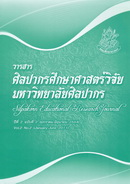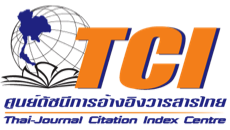การพัฒนาบทเรียนคอมพิวเตอร์ช่วยสอนภาษาอังกฤษสำหรับนักศึกษาพยาบาลศาสตร์
คำสำคัญ:
CALL Lessons, Design and Development of CALL, English for Nursing Scienceบทคัดย่อ
บทคัดย่อ
การวิจัยครั้งนี้มีวัตถุประสงค์เพื่อ (1) พัฒนาบทเรียนคอมพิวเตอร์ช่วยสอนภาษาอังกฤษสำหรับนักศึกษาพยาบาลศาสตร์ (2) เปรียบเทียบผลสัมฤทธิ์ทางการเรียนของนักศึกษาพยาบาลศาสตร์ก่อนและหลังเรียนด้วยบทเรียนคอมพิวเตอร์ช่วยสอน (3) ศึกษาความคิดเห็นของนักศึกษาที่มีต่อบทเรียนดังกล่าว กลุ่มตัวอย่างที่ใช้ในการวิจัยครั้งนี้เป็นนักศึกษาพยาบาลศาสตร์ ชั้นปีที่ 3 มหาวิทยาลัยคริสเตียน จำนวน 30 คน โดยใช้วิธีการเลือกแบบอาสาสมัคร เครื่องมือที่ใช้ในงานวิจัยประกอบด้วย (1) บทเรียนคอมพิวเตอร์ช่วยสอนภาษาอังกฤษสำหรับนักศึกษาพยาบาลศาสตร์ จำนวน 4 บทเรียน (2) แบบทดสอบก่อนและหลังเรียน (3) แบบบันทึกหลังเรียน และ (4) แบบสัมภาษณ์กึ่งมีโครงสร้าง การวิเคราะห์ข้อมูล ใช้สถิติ t-test แบบจับคู่ ค่าร้อยละ ค่าเฉลี่ย และค่าส่วนเบี่ยงเบนมาตรฐาน และการใช้วิธีการวิเคราะห์เนื้อหาสำหรับข้อมูลเชิงคุณภาพ
ผลการวิจัยพบว่า (1) บทเรียนคอมพิวเตอร์ช่วยสอนภาษาอังกฤษสำหรับนักศึกษาพยาบาลศาสตร์ มีค่าประสิทธิภาพเท่ากับ 82.98/82.78 สูงกว่าเกณฑ์มาตรฐานที่กำหนด80/80 (2) ผลสัมฤทธิ์ทางการเรียนของนักศึกษาสูงขึ้นหลังเรียนด้วยบทเรียนคอมพิวเตอร์ช่วยสอนภาษาอังกฤษสำหรับนักศึกษาพยาบาลศาสตร์ อย่างมีนัยสำคัญทางสถิติที่ระดับ 0.05 (3) นักศึกษามีความคิดเห็นเชิงบวกต่อบทเรียนคอมพิวเตอร์ช่วยสอนภาษาอังกฤษสำหรับนักศึกษาพยาบาลศาสตร์ทั้งในแง่ของเนื้อหาและวิธีการเรียนรู้
Abstract
This study was conducted in order to (1) develop Computer-Assisted Language Learning (CALL) English Lessons for Nursing Science Students; (2) explore the language achievement of students who learned with CALL English lessons before and after the lessons; and (3) investigate students’ opinions toward CALL English lessons. The subjects of the study were 30 third-year nursing students at Christian University of Thailand who were selected on a voluntary basis. The research instruments included 1) four CALL English Lessons for Nursing Science Students, 2) pre-test and post-test, 3) students’ learning logs, and 4) semi-structured interview. The descriptive statistics and the paired-sample t-test were used to analyze the quantitative data. The content-analysis was employed to find recurrent patterns in the qualitative data analysis.
It was found that (1) the efficiency of CALL English Lessons for Nursing Science students was 82.98/ 82.78 which was above the 80/80 proposed standard criteria. (2) The language learning achievement of students after learning with CALL English Lessons increased and was significantly different at the level of 0.05. (3) The students had positive opinions toward learning with CALL English Lessons for Nursing Science students in both contents and learning methods.
Keywords: CALL Lessons/ Design and Development of CALL/ English for Nursing Science





